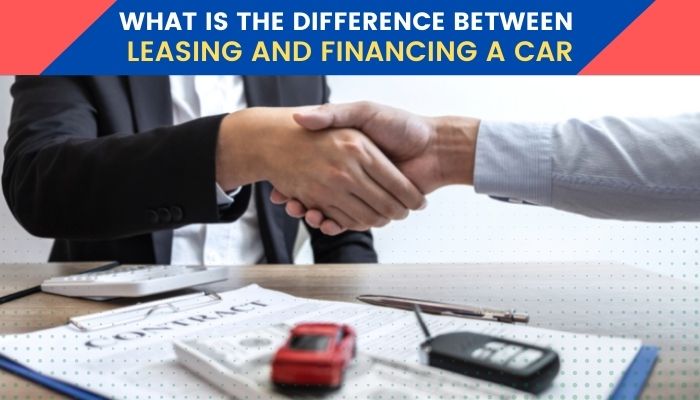What is Leasing a Car and How Does it Work?
Car leasing has become an increasingly popular option for drivers who want to experience the thrill of driving a new car without the long-term commitment of ownership. Yet, many people still struggle to fully grasp the concept of leasing and how it differs from buying a car. In this comprehensive guide, we will unravel the mystery of car leasing, providing you with a clear understanding of what it is, how it works, and the factors you need to consider before signing on the dotted line. Armed with this knowledge, you’ll be well-equipped to make an informed decision and find the perfect lease arrangement for your needs.
What is Car Leasing?
Car leasing is a contractual agreement between a customer and a leasing company that allows the customer to use a vehicle for a predetermined period without actually owning it. In simpler terms, it’s like renting a car long-term. The customer, or lessee, pays a fixed monthly fee to the leasing company, or lessor, in exchange for the right to drive the vehicle for the duration of the lease term.
Car leasing differs from buying a car in several ways. When you buy a car, you make a down payment, finance the remaining cost through a loan, and eventually gain full ownership once the loan is paid off. In contrast, when you lease a car, you only pay for the vehicle’s depreciation during the lease term, which often results in lower monthly payments compared to financing a car purchase.
There are two main types of car leases:
- Open-end lease: In an open-end lease, the lessee assumes the risk of the vehicle’s residual value at the end of the lease term. If the car’s actual market value is lower than the predetermined residual value, the lessee must pay the difference. On the other hand, if the car’s market value is higher than the residual value, the lessee may benefit by receiving the difference.
- Closed-end lease: Also known as a “walk-away” lease, a closed-end lease is the most common type of car lease. In this arrangement, the lessee is not responsible for the vehicle’s residual value at the end of the lease term. As long as the lessee adheres to the lease terms, such as mileage limits and wear-and-tear guidelines, they can simply return the vehicle and walk away or choose to lease another car.
How Does Leasing a Car Work?
Leasing a car involves a series of steps that begin with finding the right vehicle and end with returning the car or choosing a new lease at the end of the term. Here’s a breakdown of the process:
- Finding the right car: Start by researching various car models and their features, taking into account your needs, preferences, and budget. Visit dealerships to test drive the cars you’re interested in to ensure they meet your expectations.
- Negotiating lease terms: Once you’ve chosen a car, it’s time to negotiate the lease terms with the dealership or leasing company. Key factors to consider during negotiations include:
- Lease Duration: Typically, leases last between 24 to 48 months, but you can negotiate the term length based on your preferences and financial situation.
- Mileage limits: Most leases come with an annual mileage limit, usually ranging from 10,000 to 15,000 miles. Ensure the limit suits your driving habits, and remember that exceeding the limit may result in additional fees.
- Monthly payments: The monthly lease payment is determined by factors such as the car’s depreciation, interest rate (money factor), and taxes. Aim to negotiate the lowest possible payment based on the car’s capitalized cost and residual value.
- Driving and maintaining the leased car: During the lease term, drive the car as if it were your own, but keep in mind the mileage limits and wear-and-tear guidelines. Regular maintenance, such as oil changes and tire rotations, is crucial to avoid potential charges when you return the car.
- Lease-end options: As the lease term comes to an end, you’ll have several options to choose from:
- Return the car: If you opt for a closed-end lease, you can simply return the vehicle, provided it meets the lease terms regarding mileage and wear and tear.
- Lease a new car: Many lessees choose to lease another car at the end of their current lease, starting the process anew.
- Purchase the car: Some leasing contracts offer the option to buy the car at the end of the lease term, based on a predetermined purchase price. This can be a viable choice if you’ve grown attached to the car or if its market value is higher than the purchase price.
By understanding how car leasing works, you’ll be better prepared to navigate the process and secure a lease that suits your needs and preferences.
Benefits of Car Leasing
Car leasing offers several advantages over purchasing a car, making it an attractive option for many drivers. Some of the key benefits of car leasing include:
- Lower monthly payments: Since you’re only paying for the car’s depreciation during the lease term and not the full cost of the vehicle, monthly lease payments are generally lower than loan payments for purchasing a car. This allows you to drive a more expensive or luxurious car for a lower monthly cost than if you were to buy it.
- Access to the latest car models: Leasing makes it easy to drive a new car every few years, giving you the opportunity to enjoy the latest features, technology, and safety advancements. This constant access to new models can be particularly appealing to those who value staying up-to-date with automotive trends.
- Warranty coverage: Most lease terms align with the manufacturer’s warranty, ensuring that the car remains under warranty for the duration of the lease. This means that any major repairs or defects will likely be covered, reducing your out-of-pocket expenses for maintenance and repairs.
- Tax advantages: For those who use their car for business purposes, leasing can offer tax benefits. A portion of the lease payment may be tax-deductible as a business expense, depending on the specific tax laws and regulations in your area. It’s important to consult with a tax professional to understand the potential tax advantages of leasing a car for business use.
Overall, car leasing can provide financial flexibility, access to new vehicles, and reduced maintenance costs, making it an appealing option for many drivers. However, it’s essential to weigh these benefits against the drawbacks and your personal driving habits before deciding if leasing is the right choice for you.
Drawbacks of Car Leasing
While car leasing offers several benefits, it also comes with certain drawbacks that you should consider before entering into a lease agreement. Some of the key disadvantages of car leasing include:
- Limited ownership: When you lease a car, you never actually own the vehicle. Instead, you’re simply renting it for a predetermined period. At the end of the lease term, you have to return the car or lease another one, which means you won’t build any equity or have an asset to sell or trade in.
- Mileage restrictions: Most car leases come with an annual mileage limit, which can range from 10,000 to 15,000 miles or more, depending on the terms of your contract. If you exceed the mileage limit, you’ll likely face additional charges, which can be costly. This can be a significant drawback for those who drive long distances or have unpredictable driving habits.
- Potential charges for wear and tear: Leasing companies expect the vehicle to be returned in good condition, with only normal wear and tear. Excessive wear, damage, or modifications to the car can result in additional fees when you return the vehicle at the end of the lease term. These fees can add up, making leasing less attractive if you’re not diligent about maintaining the car’s condition.
- Difficulty in early lease termination: Ending a lease early can be challenging and expensive. Lease contracts usually include penalties for early termination, which can involve hefty fees or even the requirement to pay the remaining lease payments. This lack of flexibility can be a drawback for those whose circumstances change and who need to end the lease early.
While car leasing has its benefits, it’s essential to weigh these drawbacks against your personal needs and preferences to determine if leasing is the right choice for you. By carefully considering both the advantages and disadvantages, you’ll be better equipped to make an informed decision about whether to lease or buy a car.
Factors to Consider Before Leasing
Before deciding to lease a car, it’s important to carefully consider various factors to ensure that leasing is the right choice for your specific situation. Here are some key factors to keep in mind:
- Driving habits and needs: Evaluate your driving habits, such as the average distance you drive annually and the type of driving you do (city, highway, off-road, etc.). If you drive long distances or require a specific type of vehicle for your lifestyle, leasing may not be the best option due to mileage restrictions and potential wear-and-tear charges.
- Financial stability: Assess your financial situation, including your monthly budget and long-term financial goals. Leasing might be more affordable in the short term due to lower monthly payments, but remember that you won’t build any equity in the car. Consider whether leasing aligns with your financial priorities and goals.
- Credit score requirements: Leasing companies generally require a good credit score to approve a lease, as they want to ensure that you can make the monthly payments. If you have a low credit score, you may face higher interest rates or have difficulty securing a lease. In such cases, buying a car or improving your credit score before leasing might be a better option.
- Lease vs. buy comparison: Perform a thorough comparison of the costs and benefits associated with leasing versus buying a car. This should include factors such as monthly payments, total cost of ownership, depreciation, insurance, taxes, and potential resale or trade-in value. By comparing these factors, you can determine which option best suits your financial needs and preferences.
Taking the time to consider these factors will help you make an informed decision about whether leasing a car is the right choice for you. It’s crucial to weigh the pros and cons of leasing against your personal needs, financial situation, and driving habits before committing to a lease agreement.
Tips for a Successful Car Lease
To ensure a positive car leasing experience, it’s important to keep several tips in mind. Following these guidelines will help you navigate the leasing process, negotiate the best deal, and make the most of your leased vehicle:
- Understanding lease terminology: Familiarize yourself with common lease terms, such as capitalized cost, residual value, money factor, and lease inception fees. Knowing these terms will enable you to better understand the leasing process and make informed decisions during negotiations.
- Negotiating the best deal: Don’t be afraid to negotiate the terms of your lease, including the capitalized cost, lease duration, and mileage limits. Research the market value of the car and any available incentives or rebates to ensure you’re getting a fair deal. Remember that a lower capitalized cost and a higher residual value will result in lower monthly payments.
- Maintaining the leased car: Treat the leased car as if it were your own, and keep up with regular maintenance, such as oil changes, tire rotations, and inspections. This will help you avoid potential wear-and-tear charges at the end of the lease term and ensure the car remains in good condition.
- Planning for lease-end options: Before the lease term ends, consider your options for returning the car, leasing a new vehicle, or purchasing the car. Planning ahead will give you ample time to research new models, negotiate lease terms, or secure financing if you decide to buy the car.
- Monitoring your mileage: Keep track of the miles you drive throughout the lease term to ensure you don’t exceed the mileage limit specified in your contract. If you anticipate driving more miles than initially agreed upon, consider negotiating a higher mileage limit at the beginning of the lease or be prepared to pay additional fees for excess mileage.
- Inspecting the vehicle before returning it: Prior to returning the leased car, conduct a thorough inspection to identify any excessive wear or damage. Addressing these issues before the lease-end inspection can help you avoid potential charges from the leasing company.
By following these tips, you’ll be better equipped to navigate the car leasing process and enjoy a successful lease experience. Remember to carefully consider your personal needs, preferences, and financial situation to ensure that leasing is the right choice for you.
Conclusion
In conclusion, car leasing can be an attractive option for those who want to enjoy the benefits of driving a new vehicle without the long-term commitment of ownership. With lower monthly payments, access to the latest car models, and warranty coverage, leasing offers several advantages over purchasing a car. However, it’s essential to consider the drawbacks, such as limited ownership, mileage restrictions, and potential wear-and-tear charges, before deciding to lease.
By understanding the leasing process, negotiating the best deal, and carefully considering your personal needs, financial situation, and driving habits, you can determine if leasing is the right choice for you. By following the tips and guidelines provided in this guide, you’ll be well-equipped to navigate the car leasing process and enjoy a successful lease experience.
Frequently Asked Questions (FAQ)
Can I buy the leased car at the end of the lease term?
Yes, most lease contracts include an option to purchase the vehicle at the end of the lease term for a predetermined price, known as the residual value. If you’re interested in buying the car, make sure to review the terms of your lease agreement and discuss the purchase option with your leasing company.
Can I negotiate the terms of a car lease?
Absolutely! Just like when purchasing a car, you can negotiate various aspects of a car lease, such as the capitalized cost, lease duration, and mileage limits. Conduct thorough research and be prepared with information about the car’s market value and available incentives to help you secure the best possible deal.
What happens if I exceed the mileage limit on my car lease?
If you exceed the mileage limit specified in your lease agreement, you’ll likely face additional fees for each mile driven over the limit. These fees can vary depending on the leasing company and the specific terms of your contract, so it’s essential to review your lease terms and plan your driving habits accordingly.
Is it possible to terminate a car lease early?
While it’s possible to terminate a car lease early, doing so can be costly and challenging. Lease contracts typically include penalties for early termination, which can involve paying hefty fees or the remaining lease payments. Before signing a lease, consider whether the lease term aligns with your needs and be aware of the potential costs associated with early termination.
Can I customize or modify a leased car?
It’s generally not recommended to make significant modifications or customizations to a leased car, as these changes could be considered excessive wear or damage, resulting in additional charges when you return the vehicle. If you wish to make minor customizations, such as installing a roof rack, consult your leasing company to ensure the changes are permitted and won’t result in penalties.




